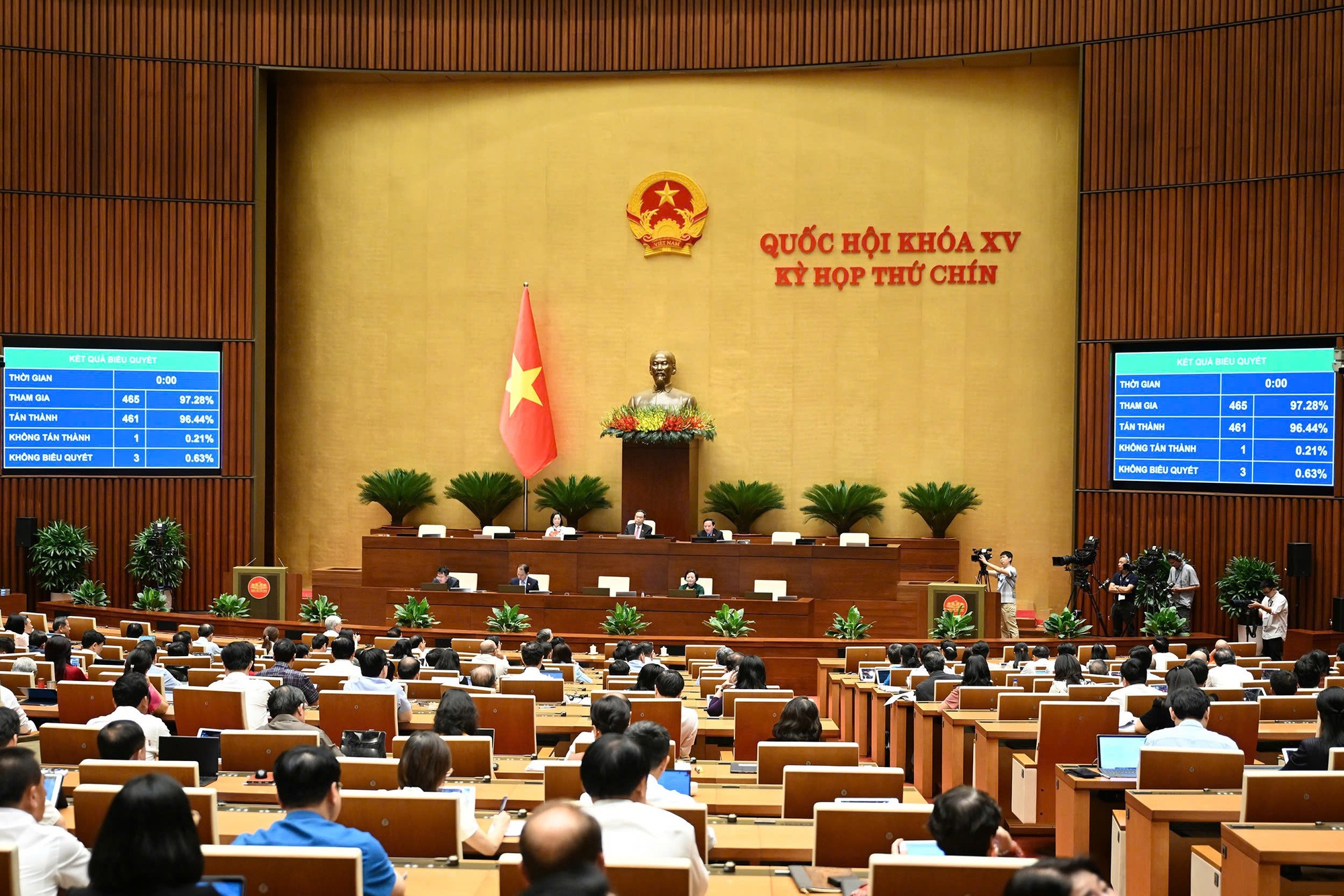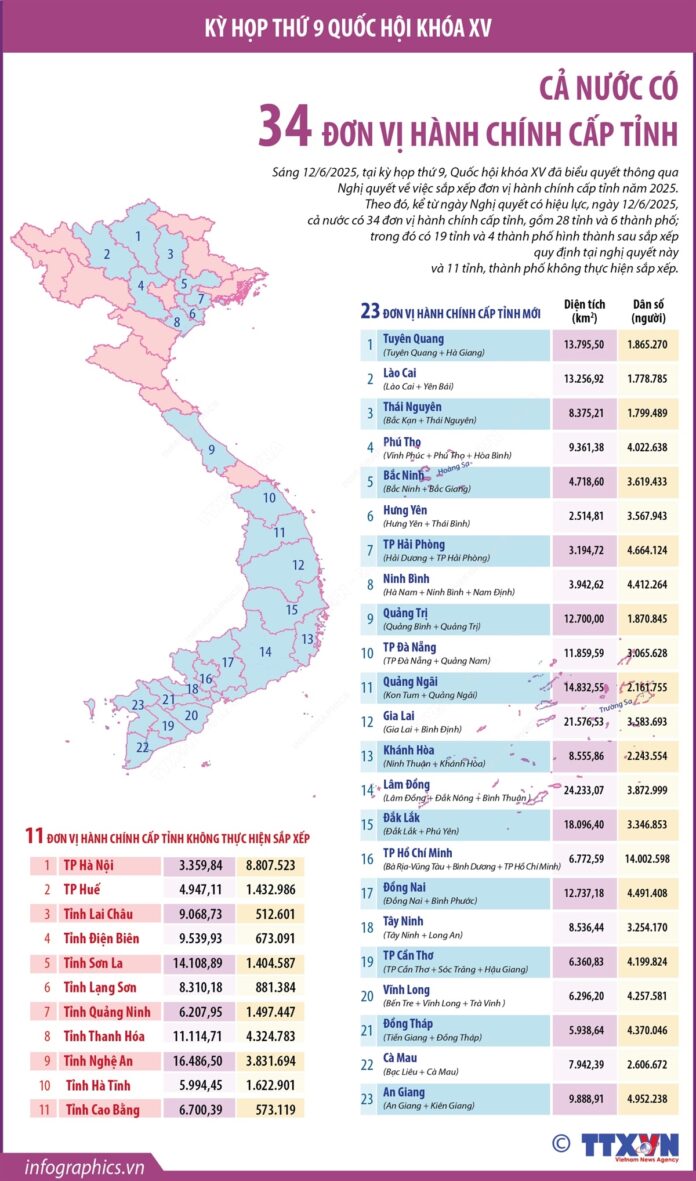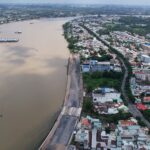
34 administrative units at the provincial level. Graphic by Vietnam News Agency
On June 12, 2025, at the 9th session of the 15th National Assembly, a resolution was passed on the rearrangement of administrative units at the provincial level for the year 2025.
Accordingly, from the effective date of this resolution, June 12, 2025, there are 34 administrative units at the provincial level across the country, including 28 provinces and 6 cities. Among these, 19 provinces and 4 cities were formed after the rearrangement stipulated in this resolution, while 11 provinces and cities remained unchanged.
Details of the Provinces and Cities Formed After the Rearrangement
The entire natural area and population of Yen Bai province and Lao Cai province were rearranged to form a new province named Lao Cai. After the rearrangement, Lao Cai province has a natural area of 13,256.92 km² and a population of 1,778,785 people.
The entire natural area and population of Bac Kan province and Thai Nguyen province were rearranged to form a new province named Thai Nguyen. After the rearrangement, Thai Nguyen province has a natural area of 8,375.21 km² and a population of 1,799,489 people.
The entire natural area and population of Vinh Phuc province, Hoa Binh province, and Phu Tho province were rearranged to form a new province named Phu Tho. After the rearrangement, Phu Tho province has a natural area of 9,361.38 km² and a population of 4,022,638 people.
The entire natural area and population of Bac Giang province and Bac Ninh province were rearranged to form a new province named Bac Ninh. After the rearrangement, Bac Ninh province has a natural area of 4,718.6 km² and a population of 3,619,433 people.
The entire natural area and population of Thai Binh province and Hung Yen province were rearranged to form a new province named Hung Yen. After the rearrangement, Hung Yen province has a natural area of 2,514.81 km² and a population of 3,567,943 people.
The entire natural area and population of Hai Phong city and Hai Duong province were rearranged to form a new city named Hai Phong. After the rearrangement, Hai Phong city has a natural area of 3,194.72 km² and a population of 4,664,124 people.
The entire natural area and population of Ha Nam province, Nam Dinh province, and Ninh Binh province were rearranged to form a new province named Ninh Binh. After the rearrangement, Ninh Binh province has a natural area of 3,942.62 km² and a population of 4,412,264 people.
The entire natural area and population of Quang Binh province and Quang Tri province were rearranged to form a new province named Quang Tri. After the rearrangement, Quang Tri province has a natural area of 12,700 km² and a population of 1,870,845 people.

The entire natural area and population of Da Nang city and Quang Nam province were rearranged to form a new city named Da Nang. After the rearrangement, Da Nang city has a natural area of 11,859.59 km² and a population of 3,065,628 people.
The entire natural area and population of Kon Tum province and Quang Ngai province were rearranged to form a new province named Quang Ngai. After the rearrangement, Quang Ngai province has a natural area of 14,832.55 km² and a population of 2,161,755 people.
The entire natural area and population of Binh Dinh province and Gia Lai province were rearranged to form a new province named Gia Lai. After the rearrangement, Gia Lai province has a natural area of 21,576.53 km² and a population of 3,583,693 people.
The entire natural area and population of Ninh Thuan province and Khanh Hoa province were rearranged to form a new province named Khanh Hoa. After the rearrangement, Khanh Hoa province has a natural area of 8,555.86 km² and a population of 2,243,554 people.
The entire natural area and population of Dak Nong province, Binh Thuan province, and Lam Dong province were rearranged to form a new province named Lam Dong. After the rearrangement, Lam Dong province has a natural area of 24,233.07 km² and a population of 3,872,999 people.
The entire natural area and population of Phu Yen province and Dak Lak province were rearranged to form a new province named Dak Lak. After the rearrangement, Dak Lak province has a natural area of 18,096.4 km² and a population of 3,346,853 people.
The entire natural area and population of Ho Chi Minh City, Ba Ria-Vung Tau province, and Binh Duong province were rearranged to form a new city named Ho Chi Minh City. After the rearrangement, Ho Chi Minh City has a natural area of 6,772.59 km² and a population of 14,002,598 people.
The entire natural area and population of Binh Phuoc province and Dong Nai province were rearranged to form a new province named Dong Nai. After the rearrangement, Dong Nai province has a natural area of 12,737.18 km² and a population of 4,491,408 people.
The entire natural area and population of Long An province and Tay Ninh province were rearranged to form a new province named Tay Ninh. After the rearrangement, Tay Ninh province has a natural area of 8,536.44 km² and a population of 3,254,170 people.
The entire natural area and population of Can Tho city, Soc Trang province, and Hau Giang province were rearranged to form a new city named Can Tho. After the rearrangement, Can Tho city has a natural area of 6,360.83 km² and a population of 4,199,824 people.
The entire natural area and population of Ben Tre province, Tra Vinh province, and Vinh Long province were rearranged to form a new province named Vinh Long. After the rearrangement, Vinh Long province has a natural area of 6,296.2 km² and a population of 4,257,581 people.
The entire natural area and population of Tien Giang province and Dong Thap province were rearranged to form a new province named Dong Thap. After the rearrangement, Dong Thap province has a natural area of 5,938.64 km² and a population of 4,370,046 people.
The entire natural area and population of Bac Lieu province and Ca Mau province were rearranged to form a new province named Ca Mau. After the rearrangement, Ca Mau province has a natural area of 7,942.39 km² and a population of 2,606,672 people.
The entire natural area and population of Kien Giang province and An Giang province were rearranged to form a new province named An Giang. After the rearrangement, An Giang province has a natural area of 9,888.91 km² and a population of 4,952,238 people.
Local Governments Formed After the Rearrangement Will Start Operating from July 1, 2025
The resolution also urges relevant agencies to promptly carry out the necessary preparatory work to ensure that the local governments of the provinces and cities formed after the rearrangement stipulated in Article 1 of this resolution officially operate from July 1, 2025.
The local governments of the provinces and cities before the rearrangement will continue to operate until the local governments of the provinces and cities formed after the rearrangement officially operate.
From the effective date of this resolution, there are 34 administrative units at the provincial level across the country, including 28 provinces and 6 cities.
Among these, 19 provinces and 4 cities were formed after the rearrangement, and 11 provinces and cities remained unchanged, including the provinces of Cao Bang, Dien Bien, Ha Tinh, Lai Chau, Lang Son, Nghe An, Quang Ninh, Thanh Hoa, Son La, and the cities of Hanoi and Hue.
Providing an Updated Online Administrative Map of Vietnam with 34 Provincial-Level Units
According to Ms. Do Thi Thu Thuy, Deputy Chief of Office of the Vietnam Administration of Survey and Mapping (VASDM) under the Ministry of Agriculture and Environment, when the National Assembly’s resolution on the rearrangement of administrative units at the provincial level in 2025 takes effect, the VASDM will complete the construction and provision of the Administrative Map of Vietnam at a scale of 1:1,000,000 online via the network environment and PDF-format digital maps to promptly serve the direction and administration of the Prime Minister, the management of ministries, branches, and localities, and meet the requirements of organizations and individuals.
Ministries, branches, localities, organizations, and individuals can access the website https://vnsdi.monre.gov.vn/home of the Spatial Data Infrastructure Center to look up necessary information.
On June 12, with 461 out of 465 delegates voting in favor (accounting for 96.44% of the total number of National Assembly deputies), the National Assembly passed the resolution on the rearrangement of administrative units at the provincial level in 2025. There are now 34 administrative units at the provincial level, including 28 provinces and 6 cities. The resolution takes effect from the date of its passage by the National Assembly.
From the effective date of this resolution, there are 34 administrative units at the provincial level across the country, comprising 28 provinces and 6 cities. Of these, 19 provinces and 4 cities were formed as a result of the rearrangement stipulated in this resolution, while 11 provinces and cities remained unchanged. These unchanged provinces and cities include Cao Bang, Dien Bien, Ha Tinh, Lai Chau, Lang Son, Nghe An, Quang Ninh, Thanh Hoa, Son La, Hanoi, and Hue.
52 provinces and cities were rearranged to form 23 new provincial-level administrative units: Tuyen Quang, Lao Cai, Thai Nguyen, Phu Tho, Bac Ninh, Hung Yen, Hai Phong, Ninh Binh, Quang Tri, Da Nang, Quang Ngai, Gia Lai, Khanh Hoa, Lam Dong, Dak Lak, Ho Chi Minh City, Dong Nai, Tay Ninh, Can Tho, Vinh Long, Dong Thap, Ca Mau, and An Giang.
Speaking to Vietnam News Agency about the data adjustment of the administrative map during the implementation of the rearrangement of administrative units at all levels and the construction of a two-level local government model, Ms. Do Thi Thu Thuy said that, since the beginning of 2025, in accordance with Conclusion No. 127-KL/TW dated February 28, 2025, of the Politburo and the Secretariat on the rearrangement of administrative units according to the two-level local government model, and under the direction of the leaders of the Ministry of Agriculture and Environment, the Vietnam Administration of Survey and Mapping has prepared map documents to serve important meetings of the Politburo, the Party Central Committee, the National Assembly, and the Government, as well as the Ministry of Home Affairs.
The VASDM has created the Administrative Map of Vietnam, ensuring the accurate and complete representation of administrative units according to the new rearrangement plan. It has focused on updating administrative boundary changes, standardizing the system of symbols and data codes according to national standards, and ensuring the accuracy, uniformity, and legality of each map sheet.
“Harnessing the Power of EVFTA: Accelerating Economic, Trade, and Investment Cooperation between Vietnam and Lithuania”
Vietnam, as a convenient gateway to the ASEAN market, and Lithuania, with its access to the Central and Eastern European region, present a unique opportunity for collaboration. With their respective advantages and the benefits of the EVFTA agreement, there is potential to significantly increase bilateral trade and take these numbers to new heights.
A New Wave of Swedish Investment in Vietnam: The Prime Minister’s Vision
“On his official visit to the Kingdom of Sweden, on the afternoon of June 12th, Prime Minister Pham Minh Chinh, along with Sweden’s Minister for International Development Cooperation and Foreign Trade, Benjamin Dousa, co-chaired the Vietnam-Sweden Business Forum in Stockholm. The forum, themed ‘Green Transition, Digital Transformation, and Innovation,’ aimed to foster economic cooperation and innovation between the two countries.”





















